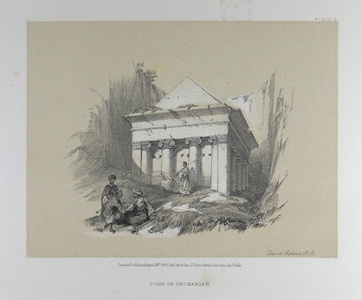| Method | Lithograph with tint stone |
| Artist | after David Roberts |
| Published | London, Published April 16th. 1855, by Day & Son, Gate Street, Lincoln's Inn Fields |
| Dimensions | Image 132 x 173 mm, Sheet 202 x 285 mm |
| Notes |
Plate 9 from Volume 1 of the small format reprint of Roberts' The Holy Land, Syria, Idumea, Arabia, Egypt & Nubia. A view of the so-called Tomb of Zechariah in the Kidron Valley in Jerusalem. The tomb is actually a monument, carved from the rock of the valley itself, and does not contain a burial chamber. It was likely constructed at a similar time to the neighbouring second-century BC Tomb of Beni Hezir, and may even be a burial monument for the family of this tomb. The monument is carved in a Hellenistic style, features an engaged ionic collonade, and a fluted Egyptian cornice topped with a pyramid. Medieval Jewish tradition held the monument to be the tomb of Zechariah, son of Jehoida, a priest referred to in the Book of Chronicles. In Roberts' view, the monument is shown half-buried. A group of men rest on the grass in front of the monument, smoking their long pipes, while a guard with a rifle patrols behind them. David Roberts RA (24th October 1796 – 25th November 1864) was a Scottish painter. He is especially known for a prolific series of detailed prints of Egypt and the Near East produced during the 1840s from sketches made during long tours of the region (1838-1840). This work, and his large oil paintings of similar subjects, made him a prominent Orientalist painter. He was elected as a Royal Academician in 1841. The firm of Day & Haghe was one of the most prominent lithographic companies of the nineteenth-century. They were also amongst the foremost pioneers in the evolution of chromolithography. The firm was established in 1823 by William Day, but did not trade under the moniker of Day & Haghe until the arrival of Louis Haghe in 1831. In 1838, Day & Haghe were appointed as Lithographers to the Queen. However, and perhaps owing to the fact that there was never a formal partnership between the two, Haghe left the firm in the 1850's to devote himself to watercolour painting. The firm continued as Day & Son under the guidance of William Day the younger (1823 - 1906) but, as a result of a scandal involving Lajos Kossuth, was forced into liquidation in 1867. Vincent Brookes bought the company in the same year, and would produce the caricatures for Gibson Bowles' Vanity Fair magazine, as well as the illustrations for Cassells's Poultry Book, amongst other commissions. Condition: Light foxing to margins, not affecting image. |
| Framing | unmounted |
| Price | £25.00 |
| Stock ID | 39283 |

